Ad
Memory efficient java tutorial practices and challenges
- 1. Building Memory-efficient Java Applications: Practices and Challenges Nick Mitchell, Gary Sevitsky (presenting) IBM TJ Watson Research Center Hawthorne, NY USA Copyright is held by the author/owner(s). ACM SIGPLAN PLDI 2009, Dublin, Ireland
- 2. Quiz
- 3. Small boxes? Q: What is the size ratio of Integer to int? a. 1 : 1 b. 1.33 : 1 c. 2 : 1 d. ? Assume 32-bit platform
- 4. Small things? Q: How many bytes in an 8-character String? a. 8 b. 16 c. 28 d. ? Assume 32-bit platform
- 5. Bigger? Better? Q: Which of the following is true about HashSet relative to HashMap a. does less, smaller b. does more, smaller c. similar amount of functionality, same size d. ?
- 6. Small collections? Q: Put the following 2-element collections in size order: ArrayList, HashSet, LinkedList, HashMap
- 7. Collections? Q: How many live collections in a typical heap? a. between five and ten b. tens c. hundreds d. ?
- 8. Roadmap Quiz Background & myths Memory health Patterns of memory usage • Case studies, with JVM background mixed in Process
- 9. Background
- 10. Background • Our group has been diagnosing memory and performance problems in large Java systems for 10 years • Built diagnosis tools used widely within IBM • most recent: Yeti • Worked with dozens of applications: open source, large commercial applications, software products • servers, clients, applications, frameworks, generated code, etc.
- 11. The big pile-up Heaps are getting bigger • Grown from 500M to 2-3G or more in the past few years • But not necessarily supporting more users or functions Surprisingly common: • requiring 1G memory to support a few hundred users • saving 500K session state per user • requiring 2M for a text index per simple document • creating 100K temporary objects per web hit Consequences for scalability, power usage, and performance
- 12. Common thread • It is easy to build systems with large memory requirements for the work accomplished • Overhead of representation of data can be 50-90% • Not counting duplicate data and unused data
- 13. The big pile-up Not a reflection on the quality of programmers – many are expert More abstractions = less awareness of costs • It is easy for costs to pile up, just piecing together building blocks The iceberg effect: App Frameworks Frameworks Frameworks Frameworks
- 14. Myths
- 15. Things are fine Objects (or Strings, HashMaps, …) are cheap Frameworks are written by experts, so they’ve been optimized (for my use case!) The JIT and GC will fix everything
- 16. Things are not fine I knew foo was expensive; I didn’t know it was this expensive! It’s no use: O-O plus Java is always expensive Efficiency is incompatible with good design
- 17. Goals • Raise awareness of costs • Give you a way to make informed tradeoffs For the research audience • Understand the walls that developers and JITs face • Many opportunities for improvement
- 18. Roadmap Quiz Background & myths Memory health Patterns of memory usage • Case studies, with JVM background mixed in Process
- 19. Patterns of memory usage Data types Collections Delegation High data High overhead Empty Small Special purpose Many, high overhead In-memory designs Correlated lifetime Short Lifetime Large, high per-entry cost Long Special purpose Fields Duplication Unused space Space vs. time Represen- tation Base class Complex temps
- 20. Roadmap Quiz Background & myths Memory health Patterns of memory usage • Modeling your data types • Modeling relationships • …. break … • More relationships • More data type modeling • Object lifetime Process
- 21. Note about measurements Measurements shown are estimates obtained from experiments on a sampling of different JVMs. In practice costs will vary across JVMs. Measures we report may be subject to errors due to data collection, analysis tools, or interpretation of results. They are intended only to illustrate the nature of memory problems.
- 22. Memory health
- 23. The idea of health TreeMap<Double, Double> (100 entries) Note: example based on Java 5 TreeMap • Schematic of a data structure • Distinguish data types from collections • A region includes all of its implementation classes TreeMap x1 = 3.9KB Double x100 = 2.3KB Double x100 = 2.3KB 100 100 Data type region Collection region Average fanout
- 24. The idea of health TreeMap<Double, Double> (100 entries) • Cost: 8.6KB • What are the bytes accomplishing? • How much is actual data vs. overhead? TreeMap x1 = 3.9KB Double x100 = 2.3KB Double x100 = 2.3KB 100 100
- 25. Data type health One Double • 33% is actual data • 67% is the representation overhead • From one 32-bit JVM. Varies with JVM, architecture. Double 24 bytes Double double JVM-imposed overhead: 16 bytes data: 8 bytes
- 26. Data type health Example: An 8-character String • only 25% is the actual data • 75% is overhead of representation • would need 96 characters for overhead to be 20% or less 8-char String 64 bytes String JVM overhead 16 bytes chars char[] bookkeeping fields 12 bytes JVM overhead 16 bytes data 16 bytes pointer 4 bytes
- 27. Collection health A 100-entry TreeMap • How does a TreeMap spend its bytes? • Collections have fixed and variable costs TreeMap x1 = 3.9KB TreeMap TreeMap$Entry Fixed overhead: 48 bytes Per-entry overhead: 40 bytes data
- 28. Data structure health TreeMap<Double, Double> (100 entries) • 82% overhead overall • Design enables updates while maintaining order • Is it worth the price? TreeMap x1 = 3.9KB Double x100 = 2.3KB Double x100 = 2.3KB 100 100 100% overhead 67% overhead
- 29. Data structure health Alternative implementation (100 entries) • Binary search against sorted array • Less functionality – suitable for load- then-use scenario • 2% overhead double[] 1x = 816 bytes double[] 1x = 816 bytes 2% overhead
- 30. Health as a gauge of scalability TreeMap<Double, Double> (10,000 entries) • Overhead is still 82% of cost • Overhead is not amortized in this design • High constant cost per element: 88 bytes Double x10000 = 234KB Double x10000 = 234KB 10000 10000 TreeMap x1 = 391KB
- 31. Health as a gauge of scalability TreeMap<Double, Double> • Overhead is still 82% of cost • Overhead is not amortized in this design • High constant cost per element: 88 bytes 82% 88% 1 100K 200K 300K 400K Data Overhead
- 32. Health as a gauge of scalability Alternative implementation • Overhead starts out low, quickly goes to 0 • Cost per element is 16 bytes, pure data double[] double[] ~ 0% overhead 0%2% 1 100K 200K 300K 400K Data Overhead
- 33. Summary: Health Distinguish actual data from the overhead of representation: • Overhead from your data types • Overhead from your collection choices, fixed vs. variable • Many other ways to break down overhead costs • JVM object overhead, delegation costs, empty array slots, unused fields, duplicate data, ... Can help answer: • How much room for improvement? • Is the functionality worth the price? • Which overhead will be amortized? If constant, how large?
- 34. Patterns of memory usage Data types Collections Delegation High data High overhead Empty Small Special purpose Many, high overhead In-memory designs Correlated lifetime Short Lifetime Large, high per-entry cost Long Special purpose Fields Duplication Unused space Space vs. time Represen- tation Base class Complex temps
- 35. Modeling your data types • High-overhead data types • Object and delegation costs
- 36. Background: the cost of objects From experiment on one 32-bit JVM Boolean 16 bytes header 12 bytes boolean 1 byte alignment 3 bytes Double 24 bytes header 12 bytes double 8 bytes char[2] 24 bytes header 16 bytes 2 chars 4 bytes • JVM & hardware impose costs on objects. Can be substantial for small objects • Headers enable functionality and performance optimizations • 8-byte alignment in this JVM • Costs vary with JVM, architecture alignment 4 bytes alignment 4 bytes
- 37. The cost of delegation Example: An 8-character String • 31% is overhead due to modeling as two objects • Effect varies with size of String 8-char String 64 bytes String JVM overhead 16 bytes chars char[] bookkeeping fields 12 bytes JVM overhead 16 bytes data 16 bytes pointer 4 bytes
- 38. The culture of objects C++ has 5 ways to organize fields into data types. Java has 2. • Delegation • Composition • Single inheritance • Multiple inheritance • Union types Software engineering culture favors reuse and loosely coupled designs
- 39. Fine-grained modeling Case study: server framework, part of connection • 34 instances to represent a request. Cost: 1.5K per request. Will not scale. • 36% of cost is delegation overhead • Constant overhead per Request • Can magnify the costs of other choices Request x46K = 67MB Request info one Request Entry EntryEntry Params Url NameAddress Params Params Url NameAddress Params Url NameAddress Params From ContactTo … …
- 40. Modeling your data types • Background: 32- vs. 64-bit JVMs
- 41. 32- vs. 64-bit • 64-bit architectures can have a big impact on memory costs. Especially in designs that have a lot of small objects and pointers • Using 64-bit addressing to solve memory problems can cause new ones • Increases object header, alignment, and pointer overhead • One study shows 40-50% avg. increase in heap sizes for benchmarks • Most JVMs have options for extended 32-bit addressing, allowing access to larger heaps without the footprint cost • e.g. IBM Java 6 sr2 compressed addressing allows ~28GB
- 42. 32- vs. 64-bit Example: An 8-character String • 50% larger • Delegated design is responsible for extra object header and pointer costs • Fine-grained designs incur especially high costs 8-char String 96 bytes String JVM overhead 24 bytes chars char[] bookkeeping fields 12 bytes JVM overhead 24 bytes data 16 bytes pointer 8 bytes alignment 4 bytes
- 43. Modeling your data types • High-overhead data types • Large instance sizes
- 44. Bookkeeping fields Simple example: an 8-character String • String users pay a 12- byte tax to store offset, length, hashcode. Just one needed for common cases. • 19% overhead for an 8-char String • Premature optimization. Cautionary tale for library designers! 8-char String 64 bytes String JVM overhead 16 bytes chars char[] bookkeeping fields 12 bytes JVM overhead 16 bytes data 16 bytes pointer 4 bytes
- 45. Large instance sizes II Case study: CRM system, part of session data • Highly delegated design • ~40 instances each • Large base class and subclasses, in addition to delegation costs • Problem 1: • Functionality too fine grained • Magnifies base class • Problem 2: • Storing computed fields Profile x1.95K = 4.6MB Profile Party Date Date PhysicalAddress PhoneNumberElectronicAddress … …… … Date Date DateDate Object 12 ContactInfo 40 Date createDate Party enteredBy Date updateDate Party updateBy Object primary int typeId String type … ElectronicAddress 48 … total: 100 Object 12 ContactInfo 40 Date createDate Party enteredBy Date updateDate Party updateBy Object primary int typeId String type … PhysicalAddress 100 … total: 152 Object 12 ContactInfo 40 Date createDate Party enteredBy Date updateDate Party updateBy Object primary int typeId String type … PhoneNumber 60 … total: 112
- 46. Large instance sizes III Case study: Modeling framework • Goal: model-based programming • Support models with 100K objects • Problem: high base framework costs • and forces modelers into inefficient choices • Many causes • Some superficial, some deeper Modeled object 68 bytes + your object cost ModelObjectImpl JVM overhead 16 bytes PropertiesHolder bookkeeping 16 bytes JVM overhead 12 bytes bookkeeping 20 bytes pointer 4 bytes
- 47. Large instance sizes III Case study: Modeling framework • Problem: constant field (Class) stored as instance variable • Replaced with static method • Problem: fields supporting features not used in many models • e.g. notification, dynamic types • Refactored, introducing BasicObjectImpl with no storage Modeled object 68 bytes + your object cost ModelObjectImpl JVM overhead 16 bytes PropertiesHolder bookkeeping 16 bytes JVM overhead 12 bytes bookkeeping 20 bytes pointer 4 bytes
- 48. Large instance sizes III Case study: Modeling framework • Design: rarely used fields moved to side object and lazily allocated • Problem: lazy allocation not working • Fixed • Problem: 5 fields never used at the same time • Combined fields, using casts • Problem: stored computations • Recompute Modeled object 68 bytes + your object cost ModelObjectImpl JVM overhead 16 bytes PropertiesHolder bookkeeping 16 bytes JVM overhead 12 bytes bookkeeping 20 bytes pointer 4 bytes
- 49. Large instance sizes III Case study: Modeling framework • Problem: some models make heavy use of fields in side object • delegation costs • Example: memory was at a premium, so model was broken into fragments. But cross- model references require these fields! • Solution: refactoring for this case • FlatObjectImpl avoids delegation Modeled object 68 bytes + your object cost ModelObjectImpl JVM overhead 16 bytes PropertiesHolder bookkeeping 16 bytes JVM overhead 12 bytes bookkeeping 20 bytes pointer 4 bytes
- 50. Large instance sizes III Modeling framework Status • Large improvements have been made • Scalability issues still Reflections • Sound engineering is can make a difference, but … • … it can only go so far. Developers are severely constrained building object frameworks in Java Modeled object ? bytes + your object cost
- 51. Large instance sizes: patterns • Expensive base classes • Some fields not needed in the general case, or are for rarely-used features • Fine-grained designs using a common base class multiply the cost of the base class design • Data fields • Semi-constant fields • Sparse fields • Saving recomputable data unnecessarily – often the result of premature optimization. Both scalar and reference fields • Typically, many cases occur together in the same data model
- 52. Data type modeling: challenges for developers • Java’s limited data modeling means tradeoffs require care • Moving rarely-used fields to side objects incurs delegation costs • Moving sparse fields to a map incurs high map entry costs • Verifying actual costs and benefits is essential • Fixing problems of high-overhead data usually means refactoring data models • Not easy late in the cycle • Using interfaces and factories up front can help
- 53. Data type modeling: community challenges • Many more objects and pointers than other languages • x high per-object cost = 35% delegation overhead avg in heaps • Only two options for achieving variation – both are expensive • delegation vs. unused fields (large base classes) • both limit higher-level choices and magnify carelessness • Consequences all the way up the stack • Primitives as object(s): String, Date, BigDecimal, boxed scalars • Collections suffer these limitations • Many layers of frameworks implementing systems functionality • Solutions in the language / runtime?
- 54. More data type patterns later
- 56. Patterns of memory usage Data types Collections Delegation High data High overhead Empty Small Special purpose Many, high overhead In-memory designs Correlated lifetime Short Lifetime Large, high per-entry cost Long Special purpose Fields Duplication Unused space Space vs. time Represen- tation Base class Complex temps
- 57. Representing relationships • many, high-overhead collections • small collections
- 58. Small collections in context Case study: Planning system, level graph edges • Two examples of small high-overhead collections • 297K edges cost 31MB • Overhead of representation: 83% • Overhead will not improve with more vertices ArrayList x65K = 3.1MB Keys HashSet x65K = 16MB Values Edge x297K = 9MB Data Integer x65K = 1MB LevelVertex HashMap x1 = 1.8MB Index 4.5 11
- 59. Small collections in context Map with multiple values per entry • Only 5% of sets had more than a few elements each ArrayList x65K = 3.1MB Keys HashSet x65K = 16MB Values Edge x297K = 9MB Data Integer x65K = 1MB LevelVertex HashMap x1 = 1.8MB Index 4.5 11
- 60. Inside the Java collections HashSet: many embedded usage assumptions • Not a good choice for small collections • Users, look before you leap – always measure • Framework designers, beware making usage assumptions HashMap$Entry HashSet HashMap array … Key Value Reuse of library code was considered important. Cost: 24 bytes/set + 4/entry Assumes entry, key, value sets all commonly used. Cost: 12 bytes Default capacity 16. For 5-entry set: 44+ bytes empty slots. Total cost: 72+ bytes fixed 28 bytes/entry
- 61. Small collections in context Map with multiple values per entry Remedy • Switched to ArrayList. Saved 77% of that region. • HashSet functionality was not worth the cost. Uniqueness already guaranteed elsewhere Wish list • Gracefully-growing collections ArrayList x65K = 3.1MB Keys ArrayList x65K = 3.7MB Values Edge x297K = 9MB Data Integer x65K = 1MB LevelVertex HashMap x1 = 1.8MB Index 4.5 11
- 62. Small collections in context Multipart key as 2-element ArrayList • ArrayList has a high fixed cost. Also required boxing of integers. ArrayList x65K = 3.1MB Keys Values Data Integer x65K = 1MB LevelVertex Index 4.5 11 HashMap x1 = 1.8MB ArrayList x65K = 3.7MB Edge x297K = 9MB
- 63. Inside the Java collections ArrayList • Much lower fixed and variable costs than HashMap or HashSet • Fixed costs can still add up for small collections ArrayList Object[] entry Fixed costs from delegation plus bookkeeping fields. Cost of minimally sized 2-element ArrayList: 40 bytes fixed + 4 bytes/entry entry … Default size and growth policy can mean overhead from empty slots
- 64. Small collections in context Multipart key class Remedy: • Introduced Pair class (Vertex, int level) • Again, functionality of original design was not worth the cost • Reduced key overhead by 68% Pair x65K = 1.3MB Keys Values DataVertex Index 4.5 1 HashMap x1 = 1.8MB ArrayList x65K = 3.7MB Edge x297K = 9MB
- 65. Multipart key Case study: Apache Commons MultiKeyMap • Apache Commons collections frameworks has the same pattern • Paying for flexibility that’s not needed • Cost: additional 20 bytes per entry Array MultiKeyMap Array MultiKey KeyPart2 KeyPart1 Could have easily created specialized MultiKey2, MultiKey3, etc. to avoid delegation cost …
- 66. Growth policies Example: creating default-size ArrayLists • 28% overhead in ArrayLists just from empty slots • collections optimized for growth • large defaults and jumps – doubling • 10% tax on some copies Remedies: • Set initial capacity • trimToSize() after load Pair x65K = 1.3MB Keys Values DataVertex 4.5 1 Index HashMap x1 = 1.8MB ArrayList x65K = 5.2MB Edge x297K = 9MB Would be 3.7M with optimal sizing
- 67. Inside the Java Collections Cost of a 2-element collection From experiments with a few different JVMs, all 32-bit. 1080 or 8848 or 56ArrayList 184 168 96 Default size (bytes) 16116 or 168HashMap 16132 or 184HashSet 396LinkedList # of slots for 2 elements using default size Minimal size (bytes)
- 68. The cost of empty collections Case study: CRM system, part of session data • Small run had 26M of session data. Will not scale. • 210 empty collections per session = 28% of session cost Remedies: • Lazily allocate • Collections.emptySet() • Avoid giving out references Profile x1.95K = 4.6MB Person ArrayList x101K = 7.9MB SessionData x330 = under 1MB Index 70 other structures 15 MB 3
- 69. The Not-so-empty Collections • Minimum of 2 objects each – component parts are always allocated • Default sizing increases cost (e.g. 16 elements for HashMap/HashSet) Always allocates a sentinel entry HashMap Array HashSet HashMap Array ArrayList Array LinkedList LinkedList$Entry 10 slot default from API spec
- 70. Inside the Java Collections Cost of an empty collection From experiments with a few different JVMs, all 32-bit. 1080 or 8840 or 48ArrayList 136 120 48 Default size (bytes) 1656 or 120HashMap 1672 or 136HashSet 1 sentinel entry 48LinkedList Default # of slots Minimal size (bytes)
- 71. Representing relationships • many, high-overhead collections • small collections • special-purpose collections
- 72. Small concurrent maps Case study: Chat server framework • Nested CHMs: > 1600 bytes each! • Cost was 90% of this structure; 10-20% of total heap What went wrong: • Library not intended for use at this scale • Concurrency requirements were different at fine vs. coarse grain Chat session x110K = 10MB Session Concurrent- HashMap x1 = 4MB Active sessions 1 Concurrent- HashMap x110K = 173MB Subscribers Subscriber x110K = 4.2MB Subscriber 1 110K
- 73. Small concurrent maps Case study: Chat server framework Remedies: • First considered reducing width of inner ConcurrentHashMap from 16 to 3. Savings: 67% • Used Hashtable, since high level of concurrency not needed. Savings: 90+% Note: • Hashtable less expensive than similar Collections$ SynchronizedMap Chat session x110K = 10MB Session Concurrent- HashMap x1 = 4MB Active sessions 1 Hashtable x110K = 17M Subscribers Subscriber x110K = 4.2MB Subscriber 1 110K
- 74. Inside the Java Collections Wrapped collections • Design is based on delegation • Costs are significant when collections are small • Fine for larger collections Collections$ SynchronizedMap HashMap … Collections$ UnmodifiableMap HashMap … 28 bytes
- 75. Small wrapped collections • 108MB for UnmodifiableMap wrappers. 56 bytes each • Twice the cost as on a 32-bit JVM What went wrong: • Functionality not worth the cost at this scale. Unmodifiable serves a development- time purpose CachedElement x63K = 137MB Element Concurrent- HashMap x1 = 3.8MB Cache 1.01 Unmodifiable- Map x1.9M = 465MB Titles String x2M = 156MB Title 32 64K Case study: media e-commerce site (64-bit) Unmodifiable- Map x1.9M = 106M Titles HashMap x1.9M = 359MB 1
- 76. Multikey map: design I • Assume 10K vertices, 5 levels Level graph edge index: as nested map HashMap x1 = .3MB Index HashMap x10K = 2.4MB 5 Level (key) 10K Vertex (key) 10K 5 Edge list (value) (10K + 1) * HM fixed overhead 60K * HM per-entry overhead Total cost: 2.6MB
- 77. Multikey map: design II • Switching order eliminated nested collection fixed costs • Savings: 46%. Consistent savings as vertices increase • Good approach if you know the distribution Level graph edge index: nested map, reordered HashMap x1 = under 1K Index HashMap x5 = 1.4MB 10K Vertex (key) 5 Level (key) 5 10K Edge list (value) 6 * HM fixed overhead + (50K + 5) * HM per-entry overhead Total: 1.4MB
- 78. Multikey map: design III • 11% better than I, 70% worse than II. • Trading fixed costs of small collections for per-element cost in a large collection: 28-byte HM entry + 20-byte Pair • Results were surprising • Wish list: be able to extend entry classes Level graph edge index: single map, multikey HashMap x1 = 1.4MB Index Pair x50K = 1MB Vertex (key) 50K Level (key) Integer or int 50K Edge list (value) 1 * HM fixed overhead + 50K * HM per-entry overhead + 50K * Pair overhead Total: 2.4 MB 1 1
- 79. Multikey map: comparison Incremental cost per vertex • Assume num levels is much smaller than num vertices • Then II is consistently better than I • delta per vertex is constant 128 bytes • Difference of III vs. others is sensitive to the number of levels, even within a small range 0 100 200 300 400 500 600 700 2 4 6 8 10 Number of levels Bytespervertex I. II. III.
- 80. Break
- 81. Representing relationships • large collections, high per-entry overhead relative to data
- 82. Large collections and scaling • Per-element cost is constant. Constant is large relative to actual data. • Cost: 48 bytes per element Overhead: 83% What went wrong: • high collection per- entry + delegation costs Level graph edge index: single map, multikey HashMap 28*n bytes Index Pair 20*n bytes Vertex (key) n Level (key) Integer or int n Edge list (value) 1 1 Cost is dominated by HM per-entry cost + Pair cost
- 83. Inside the Java Collections Standard collections: per-entry costs. From experiments with a few different JVMs, all 32-bit. Excludes amortized per-collection costs such as empty array slots. Includes pointer to entry. 4ArrayList 28 or 36HashMap 28 or 36HashSet 24LinkedList Per-entry cost (bytes) • Plus any overhead of introducing a key or value object
- 84. Nested collections, high per-element costs • Stores 7 properties per subscription, via session API • HT per-entry, boxing costs add 350 bytes overhead per session, impeding scalability What went wrong: • Cost obscured by multiple layers, fanouts What went right: • Shared attribute names across sessions Collaboration service: storing properties Session x20K Hashtable x20K = 7M 1 Subscription x20K 1 Properties Integer, Long, etc. x140K = 2.7M 7Values7Attributes String (shared across sessions)
- 85. Nested collections, high per-element costs Remedy: • Combined properties into a single high-level property, inlining scalar values • 7 : 1 reduction in collection entry costs, plus reduced boxing costs • Note: still paying for HT fixed cost Collaboration service: storing properties Session x20K Hashtable x20K = 2.6M 1 Subscription x20K 1 Properties Subscription- Property x20K = 1.2M 1Values1Attributes String (shared across sessions)
- 86. Representing relationships • large collections, high per-entry overhead relative to data • special-purpose collections
- 87. Collections involving scalars Case study: monitoring infrastructure • Data structure took 1.2GB • Overhead is still 82% at this giant scale • Some alternative scalar maps/collections available, with much lower overhead TreeMap x52 = 537MB Double x13.4M = 342MB Double x13.4M = 342MB 265K 265K
- 88. Identity maps Comparison: HashMap vs. IdentityHashMap • For maintaining a map of unique objects, where the reference is the key • Equality based on == • Open addressing implementation avoids the cost of Entry objects • Cost reduced by 59% in this experiment HashMap x1 = 298KB 10000 Key 10000 Value IdentityHashMap x1 = 128KB 10000 Key 10000 Value
- 89. Collections & Scaling The health near the leaves will limit a design’s scalability • Fixed costs of nested collections • Constant costs for elements • Collection per-entry costs • Delegation overhead of contained data
- 90. The standard collections JDK Standard Collections • Speed has been the focus, not footprint IBM (Harmony) and Sun implementations not that different in footprint Hard-wired assumptions, few policy knobs (e.g. growth policies) Specialized collections are worth learning about: • IdentityHashMap, WeakHashMap, ConcurrentHashMap, etc.
- 91. Collections alternatives Apache Commons • Many useful collections: • Flat3Map, MultiMap, MultiKeyMap • Focus is mostly on functionality. Maps allow some extension. • Footprint similar to standard, with a few exceptions GNU Trove • Many space-efficient implementations • e.g. scalar collections • e.g. list entries without delegation cost Cliff Click nonblocking; Javolution; Amino Specialized collections within frameworks you use Important: check your corporate policy re: specific open source frameworks
- 92. Collections: summary (for developers) • Choosing and configuring carefully can make a big difference (within limits) • consider context of collections as well • Avoid writing your own if possible
- 93. Collections: community challenges • Efficiency improvements to the standard collections that match the common use cases • Implementations and APIs • Benchmarks that consider both space and time
- 94. Collections: deeper challenges • Better libraries will only go so far • e.g. a few million objects to represent a relationship • Java / runtime features to enable much more optimal representations. Some possibilities: • Richer data modeling features (e.g. to reduce delegation) • Adaptive representations • Bulk storage • Specification or inference of intent (e.g. nested maps, relationships, caches, dynamic types) • Tools that help developers make choices
- 95. Modeling your data types • Too much data
- 96. Saving formatted data I Case study: one layer of chat framework Session data: • 82% of cost of this layer, due to saving computation of toString() What went wrong? • Empty space overhead in StringBuffer • Space cost not worth the time savings Remedies: • String, not StringBuffer • Recompute as needed StringBuffer x334K = 187MB saved toString Session x111K = 42MB Session bridge 3
- 97. Saving formatted data I: delegation effects Case study: one layer of chat framework Inside each Session: • Data type had been split in three • Same coding pattern copied to each part What went wrong? • Delegated design magnified other costs SessionWrapper SessionImplSessionBase StringBuffer StringBuffer StringBuffer
- 98. Saving formatted data II Case study: CRM system Session state fragment: • Saving formatted data • Some were constants (“10%”). Some had few values (“Y”, “N”) • Storing a boolean as a String. Health ratio is 48 : 1 What went wrong? • Duplicating data with high-overhead representation • Space cost not worth the time savings String “Y” or “N” Profile Profile n String “10%”n
- 99. Duplicate, immutable data Case study: Text analysis system, concordance • 17% of cost due to duplication of Type and its String data • Only a small number of immutable Types What went wrong? • Interface design did not provide for sharing • Full cost of duplication was hidden Remedy • Use shared immutable factory pattern Concordance- Entry x131K = 41MB ConcordanceEntry Annotation … … Type String char[] 1 1 1 1
- 100. Background: sharing low-level data String.intern() • You specify which Strings to share • Shares the String object and the character array • Make sure it’s worth it, since there is a space cost • Myth that is causes memory leaks • Though can hit permspace limits Boxed scalars • Integer.valueOf(), Boolean.valueOf(), etc. • Shares some common values (not all) • Make sure you don’t rely on ==
- 101. Common-prefix data Case study: application server, class cache • Class loader map of class names to jar files • > 120M of Strings, mostly duplicate prefix information What went wrong? • Duplication cost • Deeper problem: misplaced optimization Remedy • Implemented trie • Simpler, 2-part factoring can also work String 120+ MB Class name HashMap Class map class info Class info
- 102. Dynamic types Case study: caching mechanism Granularity inflation • Object Collection • Field Object(s) Costs • 92% overhead • Barrier for JIT Many cases, variants • e.g. XML DOM, mediators, temporaries • Map version, with field names on each record Map Cache Record Cached record CacheEntry RecordImpl Object[] String Integer char[] Timestamp … Record layout implemented as a collection Each field implemented as one or more objects
- 103. Data modeling: more challenges for the community • Duplicate, unchanging data is a major source of footprint bloat • Strings as well as whole structures • Layers of encapsulation and large-scale boundaries (e.g. plugins, ear files) make duplication beyond the scope of developers to address • Strings are 30-50% of the heap, collections 10-15% or more • Why are they so prevalent? What are they representing? • Dynamic types without inflation • Both long- and short-lived
- 105. Patterns of memory usage Data types Collections Delegation High data High overhead Empty Small Special purpose Many, high overhead In-memory designs Correlated lifetime Short Lifetime Large, high per-entry cost Long Special purpose Fields Duplication Unused space Space vs. time Represen- tation Base class Complex temps
- 106. Managing object lifetime • short-lived data
- 107. Temporaries Aren’t temporary objects free these days? • Some are, and some definitely aren’t
- 108. Expensive temporaries Example: SimpleDateFormat • Costly construction process. Each call to the default constructor results in: • 123 calls to 55 distinct methods • 44 new instances • Designed for costs to be amortized over many uses • Remedy: reuse via a local variable or thread-local storage SimpleDateFormat String[] Gregorian- Calendar … String[] Decimal- Format Decimal- Format- Symbols … … int[] … Date TimeZone
- 109. Background: ThreadLocal storage • ThreadLocal: JDK-supplied per-thread variable • An application can create many of these for different purposes • Enables reuse without introducing concurrency problems
- 110. Tradeoffs • Converter, formatter, factory, schema, connection, etc. may be good candidates for reuse. They can be expensive to create, and are often designed for reuse • Use ThreadLocal or specialized resource pools, depending on requirements • Sometimes local variables are good enough • Avoid writing your own resource pools • Not worth caching simple temporaries • Some temporaries are inexpensive to create (e.g. Integer, many iterators) • ThreadLocal access is usually a hash lookup
- 111. Managing object lifetime • long-lived data
- 112. Managing lifetime: understanding requirements Three very different reasons for long-lived data 1. In-memory design. Data is in memory forever 2. Space vs. time. Data may be discarded and recomputed 3. Correlated lifetime. Data alive only during the lifetime of other objects or during specific phases Each has its own best practices and pitfalls Many problems stem from misunderstanding requirements
- 113. Managing Object Lifetime • If not careful, extending the lifetime of objects can introduce concurrency problems, leaks, and additional memory overhead from structures that manage lifetime
- 114. Managing object lifetime • long-lived data • in-memory designs
- 115. The limits of objects Case study: memory analysis tool • Some object-oriented designs will never fit in memory • Estimate and measure early Note • An earlier design used a modeling framework with high overhead costs. Just optimizing those costs would not have been sufficient. Requirement: analyze 80-million object heap Design: one object per target application object Hypothetical minimum: if each object needed just 4 fields (type, id, ptr to references, flags): 80M x 32 bytes = 2.5G just to model application objects! To model references (2-3 per object), and leave scratch space for algorithms, design would require at least 10G
- 116. The limits of objects Case study: memory analysis tool Solution: • Backing store using memory-mapped files (java.nio) • Built a column-based storage infrastructure with scalar arrays, to reduce working set and avoid object header costs • Specialized for this application’s access patterns • Don’t try this at home! • Result is highly scalable – runs in a 256M heap Recommendations: • java.nio is one way to implement a backing store • Column-based approach is a last resort. For optimization of highly specialized and protected components • some XML DOM implementations use this approach
- 117. Managing object lifetime • long-lived data • space vs. time designs
- 118. Space vs. time designs: mechanisms Mechanisms for saving time by maintaining data in memory: • caches • resource pools Also: • thread-local storage • adding computed fields to data types
- 119. Background: Soft References Soft References: • Tells GC to reclaim these objects only when the space is really needed • Will keep an object alive after it is no longer strongly referenced, just in case it is needed again • Used mostly to avoid recomputation • e.g. for caches and resource pools • e.g. for side objects (cached fields) which can be recreated if lost Weak StrongSoft
- 120. Caches & pools: a sampling Case study: class loader “cache” • > 100M of classname strings • Implemented an in-memory design. Purpose was for performance - should have been a small, bounded cache • Cache itself was only needed during startup Case study: high-volume web application • Unbounded growth (leak). An object pool framework was used for 20 different purposes, to improve performance. Unbounded size; strong references. • Solution: soft references Case study: financial web application • Cache sized too large, aiming for 95% hit rate • Result: performance problems due to excessive GC • Caches & pools should always be bounded • Larger caches aren’t necessarily better
- 121. Caches & resource pools: best practices Soft references are useful for implementing simple caches/pools, but … • Relying solely on soft references gives up control over policy • May not leave enough headroom for temporary objects, causing the GC to run more often Caches / pools should in general be bounded in size Soft references can be used as an additional failsafe mechanism Many implementations of caches and resource pools are available Avoid writing your own if possible
- 122. Managing object lifetime • long-lived data • correlated lifetime designs
- 123. Correlated lifetime Objects needed … … only while other objects are alive • e.g. annotations on existing objects • e.g. sharing pools • e.g. listeners … or during specific phases or time intervals • e.g. loading • e.g. session state, for a bounded length of time
- 124. Sharing and growing Case study: Planning system, sharing pool • Each iteration of the algorithm creates hundreds of thousands of new expressions • Used shared immutable factory pattern to save space on common subexpressions • Result: unbounded growth due to pool Subexpressions HashMap Sharing pool values Shared data Algorithm keys transient references for one iteration Keeps subexpressions (and map entries) around forever
- 125. Background: Weak References Weak Reference: • Tells GC it may reclaim an object as soon as it is no longer needed • as long as there are no stronger references to the object • Useful for preventing leaks – ties the lifetime of objects to other objects • e.g. for annotations, sharing pools, listener lists Weak StrongSoft
- 126. Sharing and not growing Case study: Planning system, sharing pool Remedy: • Apache Commons ReferenceMap (Strong, Weak) • Pool entry will be removed when value is no longer needed Note: • Also considered soft references. But each iteration used different expressions, so no need to prolong lifetime. Goal was space, not time. Subexpressions ReferenceMap Sharing pool values Shared data Algorithm keys transient references for one iteration Weak reference Strong reference
- 127. Using Weak References A few common usage patterns Weak key, strong value • The standard Java WeakHashMap. • Example usage: key = object to be annotated, value = annotation • Caution if key is the same as or strongly reachable from value Strong key, weak value • As in previous example, for sharing pool
- 128. Background: weak and soft reference costs • Weak and soft references are Objects, and so incur footprint costs • e.g. 24 bytes for each WeakReference on one 32-bit JVM • Some weak/soft maps entries extend Weak/SoftReference; others add yet another level of delegation • e.g. Apache Commons ReferenceMap: at least 2 objects per entry
- 129. Leaks & drag: a sampling Case study: CRM application • Leak: bug in end-of-request processing failed to remove an object from a listener queue • Immediate fix: fixed bug in request • For robustness: have listener queue use weak references Case study: development tool • Large index needed only during load time • Easy solution: nulled out pointer Case study: CRM application • Session state retained for 8 hours • Made worse by costly session state (200K / user) • Easy solution: fixed configuration • Failure to unregister listeners is a common cause of leaks
- 130. Entries too large Case study: CRM application • 200K session state per user! • Often a pile-up of multiple problems one session . . . … … … … … … Sessions duplicated data highly delegated representations with 100s or 1000s of instances small / empty collections large substructures retained by accident
- 131. Process • simple techniques, tools, and resources
- 132. Surprises are everywhere Case study: CRM application • Developers expected 2K and found 200K session state per user • Unit costs can be very difficult to predict at every level one session . . . … … … … … … Sessions
- 133. Measurement • Many surprises. It is essential to verify assumptions empirically throughout the lifecyle. • Not so easy with framework layers and current tools
- 134. What and when A few techniques among many: • Small, synthetic experiments are extremely valuable, to test out frameworks and design patterns before they are adopted • Of course, incorporate measurement into unit and system tests • Use detailed diagnostic tools to periodically check for scale, and look for surprises • Be mindful of normalization units when designing tests: how many concurrent users? active sessions? • Understand costs of major units used in lower layers • Run experiments at different scales early on. Are costs amortized as expected? • Cardinality of relationships: state as part of design; verify periodically; then use in combination with measurement as the basis for estimation • Caches and pools: verify that they are working and they are worth it
- 135. Managing long-lived data: challenges for the community Tools that make costs visible early • expected use of framework vs. granularity of use • unit costs, e.g. per session, per user, per data structure • predict/evaluate scalability Mechanisms for balancing competing needs for memory • current mechanisms are low level: weak and soft references • subheaps? specifying lifetime intent? • tools to validate and tune caches and pools Mechanisms to enable larger designs with backing stores • reduce transformation costs
- 136. Tools for heap analysis • For analyzing the sources of memory bloat and for verifying assumptions, tools that rely on heap snapshots are the most valuable • Some free tools from IBM and Sun • IBM DeveloperWorks & alphaWorks; Sun Developers Network • Tech preview (beta) of MDD4J in IBM Support Assistant – based on Yeti • Commercial and open source tools • Eclipse MAT open source • YourKit, JProfiler, ….
- 137. Gathering heap data • IBM and Sun diagnostic guides have information on gathering and analyzing heap snapshots, and pointers to free tools • IBM: http://www.ibm.com/developerworks/java/jdk/diagnosis/ • Sun: http://java.sun.com/javase/, info with specific JDKs • Formats • hprof: Sun & IBM • phd, javadump/DTFJ: IBM only • The choice of when to take snapshots is key • For footprint: at steady state with known load • For footprint of a single feature or for suspected growth: before/after fixed number of operations, starting after system is warmed up
- 138. Additional resources JDK library source code is freely available, and can be very worthwhile to consult Many valuable articles on the web • IBM DeveloperWorks, Sun Developer Network are good starting points • Some misinformation occasionally found on reputable sites • Best practices and tuning guides for specific frameworks Garbage collection and overall heap usage • IBM and Sun diagnosis sites have GC tuning guides, free tools • IBM Pattern Modeling and Analysis Tool for GC (PMAT) on alphaWorks, Health Center on developerWorks • Some performance analysis tools have heap monitoring features Object allocation • Most Java performance profilers can show allocation information with calling context. e.g. hprof (free)
- 139. Conclusions • Distributed development, layers of frameworks, and Java’s modeling limitations make it easy to create bloated data designs. • Awareness to costs can enable large gains without sacrificing speed or design. At the same time, there are limits to what developers can achieve. • There are many research opportunities to make the Java language, runtime, and tools better address current programming practice. • The concept of data structure health – the ratio of actual data to its representation – can illuminate where there is room for improvement, and highlight aspects of a design that will not scale.
- 140. Acknowledgments Thanks to: • Matthew Arnold • Dave Grove • Tim Klinger • Trevor Parsons • Peter Santhanam • Edith Schonberg • Yeti See also: • N. Mitchell, G. Sevitsky, “The Causes of Bloat, the Limits of Health”, OOPSLA 2007, Montreal, Canada. • N. Mitchell, E. Schonberg, G. Sevitsky, “Making Sense of Large Heaps”, ECOOP 2009, Genoa, Italy.





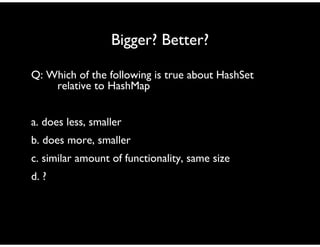









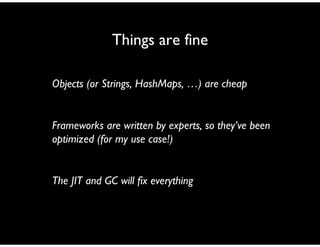










![Data type health
Example: An 8-character String
• only 25% is the
actual data
• 75% is overhead of
representation
• would need 96
characters for
overhead to be
20% or less
8-char String
64 bytes
String
JVM overhead
16 bytes
chars
char[]
bookkeeping
fields 12 bytes
JVM overhead
16 bytes
data
16 bytes
pointer
4 bytes](https://image.slidesharecdn.com/memory-efficient-java-tutorial-150902123349-lva1-app6892/85/Memory-efficient-java-tutorial-practices-and-challenges-26-320.jpg)


![Data structure health
Alternative implementation (100 entries)
• Binary search
against sorted
array
• Less functionality –
suitable for load-
then-use scenario
• 2% overhead
double[]
1x = 816 bytes
double[]
1x = 816 bytes
2%
overhead](https://image.slidesharecdn.com/memory-efficient-java-tutorial-150902123349-lva1-app6892/85/Memory-efficient-java-tutorial-practices-and-challenges-29-320.jpg)


![Health as a gauge of scalability
Alternative implementation
• Overhead starts
out low, quickly
goes to 0
• Cost per element
is 16 bytes, pure
data
double[] double[]
~ 0%
overhead
0%2%
1 100K 200K 300K 400K
Data
Overhead](https://image.slidesharecdn.com/memory-efficient-java-tutorial-150902123349-lva1-app6892/85/Memory-efficient-java-tutorial-practices-and-challenges-32-320.jpg)


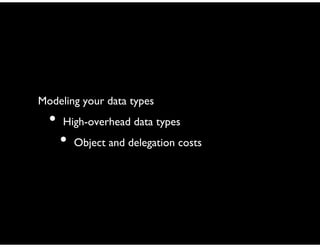
![Background: the cost of objects
From experiment on one 32-bit JVM
Boolean
16 bytes
header
12 bytes
boolean
1 byte
alignment
3 bytes
Double
24 bytes
header
12 bytes
double
8 bytes
char[2]
24 bytes
header
16 bytes
2 chars
4 bytes
• JVM & hardware impose
costs on objects. Can be
substantial for small
objects
• Headers enable
functionality and
performance
optimizations
• 8-byte alignment in this
JVM
• Costs vary with JVM,
architecture
alignment
4 bytes
alignment
4 bytes](https://image.slidesharecdn.com/memory-efficient-java-tutorial-150902123349-lva1-app6892/85/Memory-efficient-java-tutorial-practices-and-challenges-36-320.jpg)
![The cost of delegation
Example: An 8-character String
• 31% is overhead
due to modeling as
two objects
• Effect varies with
size of String
8-char String
64 bytes
String
JVM overhead
16 bytes
chars
char[]
bookkeeping
fields 12 bytes
JVM overhead
16 bytes
data
16 bytes
pointer
4 bytes](https://image.slidesharecdn.com/memory-efficient-java-tutorial-150902123349-lva1-app6892/85/Memory-efficient-java-tutorial-practices-and-challenges-37-320.jpg)


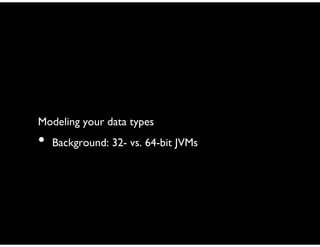

![32- vs. 64-bit
Example: An 8-character String
• 50% larger
• Delegated design is
responsible for extra
object header and
pointer costs
• Fine-grained designs
incur especially high
costs
8-char String
96 bytes
String
JVM overhead
24 bytes
chars
char[]
bookkeeping
fields 12 bytes
JVM overhead
24 bytes
data
16 bytes
pointer
8 bytes
alignment
4 bytes](https://image.slidesharecdn.com/memory-efficient-java-tutorial-150902123349-lva1-app6892/85/Memory-efficient-java-tutorial-practices-and-challenges-42-320.jpg)

![Bookkeeping fields
Simple example: an 8-character String
• String users pay a 12-
byte tax to store
offset, length,
hashcode. Just one
needed for common
cases.
• 19% overhead for an
8-char String
• Premature
optimization.
Cautionary tale for
library designers!
8-char String
64 bytes
String
JVM overhead
16 bytes
chars
char[]
bookkeeping
fields 12 bytes
JVM overhead
16 bytes
data
16 bytes
pointer
4 bytes](https://image.slidesharecdn.com/memory-efficient-java-tutorial-150902123349-lva1-app6892/85/Memory-efficient-java-tutorial-practices-and-challenges-44-320.jpg)







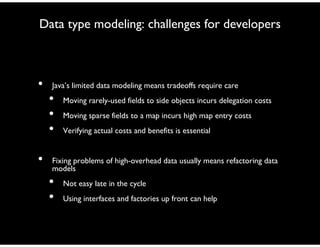









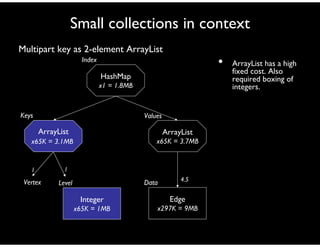
![Inside the Java collections
ArrayList
• Much lower fixed and
variable costs than
HashMap or HashSet
• Fixed costs can still
add up for small
collections
ArrayList
Object[]
entry
Fixed costs from delegation
plus bookkeeping fields.
Cost of minimally sized
2-element ArrayList:
40 bytes fixed +
4 bytes/entry
entry
…
Default size and growth
policy can mean overhead from empty slots](https://image.slidesharecdn.com/memory-efficient-java-tutorial-150902123349-lva1-app6892/85/Memory-efficient-java-tutorial-practices-and-challenges-63-320.jpg)








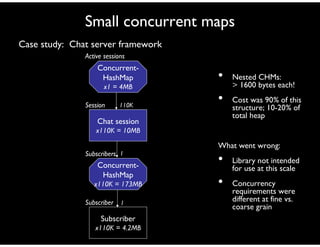

























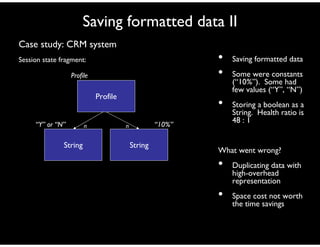
![Duplicate, immutable data
Case study: Text analysis system, concordance
• 17% of cost due to
duplication of Type and
its String data
• Only a small number of
immutable Types
What went wrong?
• Interface design did
not provide for sharing
• Full cost of duplication
was hidden
Remedy
• Use shared immutable
factory pattern
Concordance-
Entry
x131K = 41MB
ConcordanceEntry
Annotation
… …
Type
String
char[]
1
1
1
1](https://image.slidesharecdn.com/memory-efficient-java-tutorial-150902123349-lva1-app6892/85/Memory-efficient-java-tutorial-practices-and-challenges-99-320.jpg)
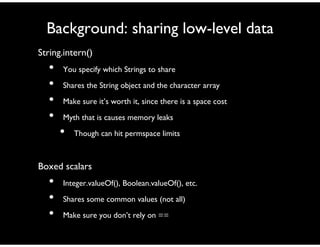

![Dynamic types
Case study: caching mechanism Granularity inflation
• Object Collection
• Field Object(s)
Costs
• 92% overhead
• Barrier for JIT
Many cases, variants
• e.g. XML DOM,
mediators, temporaries
• Map version, with field
names on each record
Map
Cache
Record
Cached record
CacheEntry
RecordImpl
Object[]
String Integer
char[]
Timestamp
…
Record layout
implemented as
a collection
Each field implemented
as one or more objects](https://image.slidesharecdn.com/memory-efficient-java-tutorial-150902123349-lva1-app6892/85/Memory-efficient-java-tutorial-practices-and-challenges-102-320.jpg)



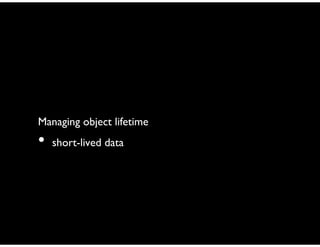

![Expensive temporaries
Example: SimpleDateFormat
• Costly construction
process. Each call to
the default constructor
results in:
• 123 calls to 55
distinct methods
• 44 new instances
• Designed for costs to
be amortized over
many uses
• Remedy: reuse via a
local variable or
thread-local storage
SimpleDateFormat
String[]
Gregorian-
Calendar
…
String[]
Decimal-
Format
Decimal-
Format-
Symbols
… …
int[]
…
Date TimeZone](https://image.slidesharecdn.com/memory-efficient-java-tutorial-150902123349-lva1-app6892/85/Memory-efficient-java-tutorial-practices-and-challenges-108-320.jpg)





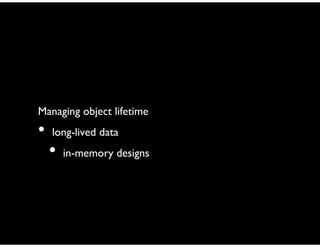


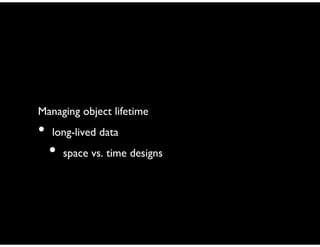
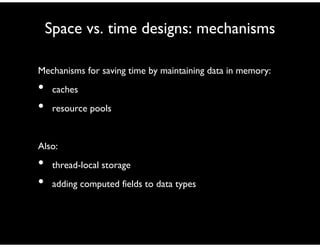




















































![JavaOne2016 - Microservices: Terabytes in Microseconds [CON4516]](https://cdn.slidesharecdn.com/ss_thumbnails/javaone2016microservicesfinal-160922163749-thumbnail.jpg?width=560&fit=bounds)
![JavaOne2016 - Microservices: Terabytes in Microseconds [CON4516]](https://cdn.slidesharecdn.com/ss_thumbnails/javaone2016microservicesfinal-160922165618-thumbnail.jpg?width=560&fit=bounds)





















































